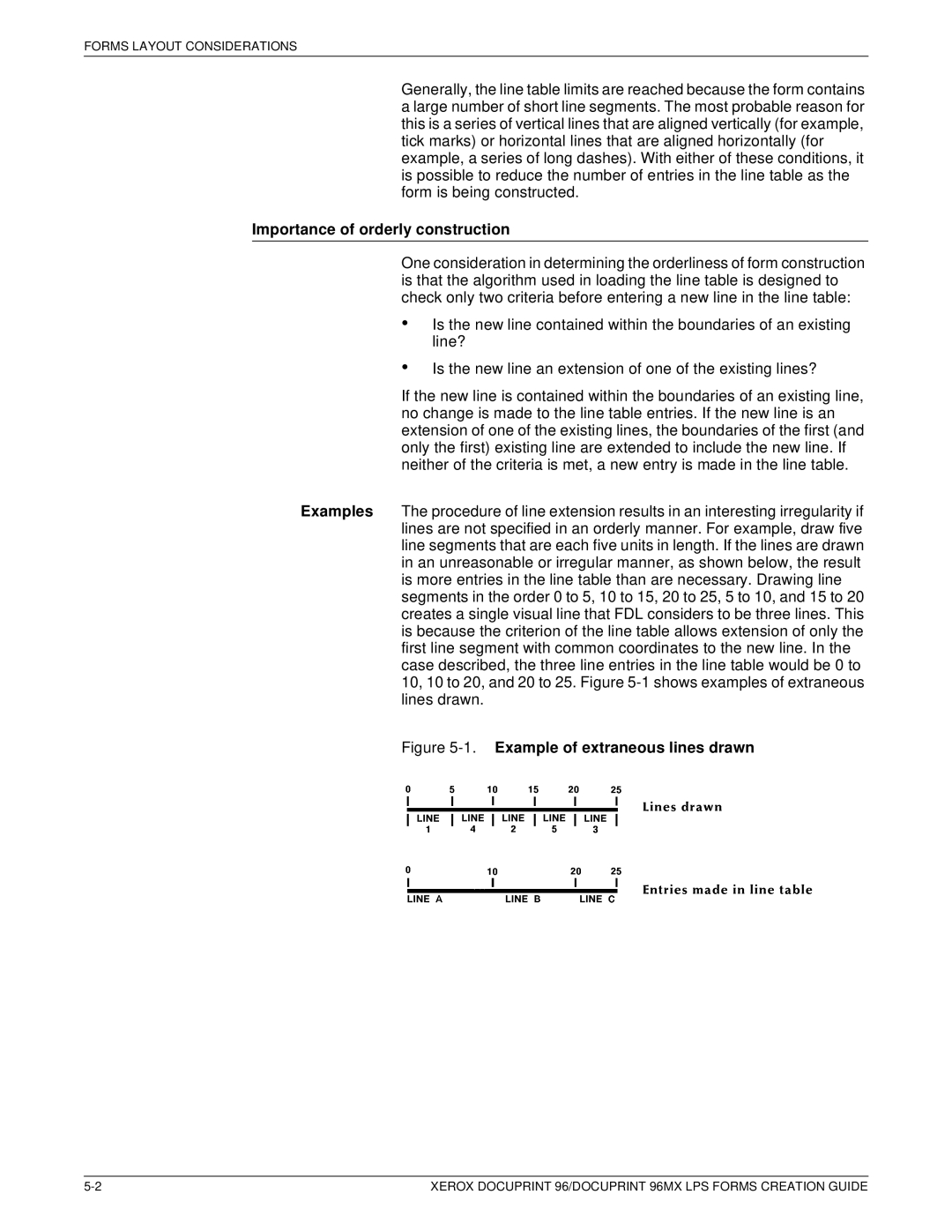April 1998 721P85630
Page
Related publications
Related Publications Number
Xerox Docuprint 96/DOCUPRINT 96MX LPS Forms Creation Guide
Table of Contents
Compiling and printing forms
Forms layout considerations
Text AT
Text in BOX
FDL command summary
Coding a complex form
Glossary
GLOSSARY-1
Index
INDEX-1
Introduction
About the reference set
Xerox DocuPrint 96/DocuPrint 96MX
LPS Operator Guide
Xerox DocuPrint 96/DocuPrint 96MX LPS PDL Reference
LPS System Generation Guide
Xerox DocuPrint 96/DocuPrint 96MX LPS Forms Creation Guide
Card
LPS Message Guide
User Guide
What this guide contains
Conventions used in this guide
Xiv
Overview
Laser printing technology
Paper
Fonts
Forms creation
Page
Basic concepts
Orientation
Landscape Portrait
Character spacing
Font orientation
Frames
Physical
System
Virtual
Form origin
Positioning form elements
Form element origin
Form element Element origin
Grids
Y coordinate
Basic Concepts
Predefined formats
Formats
Data types
FDL command overview
Forms description language
Command summary
Command format
Steps to creating a form
Form Paper LANDSCAPE/PORTRAIT Grid Font
Setup commands
Form command
Form id
Form 3BOXES
Paper command
Paper Size is Usletter A4 Uslegal A3
By y
Option Description
Using B4 paper size
Sysgened paper size is out of range
Specifying TAB as a form
Paper Size
Inches
By y Inches
LANDSCAPE/PORTRAIT command
Virtual page size
Landscape
Paper Size is n Dots Wideby m Dots High
Grid command
Centimeter Centimeters
Dots Xdots
Example 1 Landscape
Grid Unit is FMT3
Example 2 Landscape
Grid Unit is FMT1 Origin 1 Inch 1 Inch
Grid Unit is 1 CM
Form with grid specified, but no origin or format
Form with grid, origin, and page size specified
Font command
Font S id. . . id
Fonts UN106A,UN104C,UN114A
Description commands
Use of a negative coordinate
Line command
AT 3 Draw Line from 4 to
Types of lines
Draw
Line
Drawing a horizontal line rows and columns
10.Drawing parallel vertical lines
BOX command
AT 4,6 BOX 24 by 4 USI SHA HEA
Horizontally
Shading and Repeat Vertically Every
Grid Unit is 1 DOT, Origin is 0,0
Text commands
Text AT
Dots PER Line Vertical Xdots PTS LPI Aligned Left
Right Center TOP Bottom
Text command defaults
Text
Keywords Explanations
‘R#ETAIL #D#ISTRIBUTION’
Aligning text
Text Aligned Left AT 5,1 ‘FIRST’ ‘NATIONAL’ ‘TRUST’ ‘CO’
First National Trust
Text AT 5,1 ‘FIRST’ ‘NATIONAL‘ ‘TRUST’ ‘CO’
Vertical Text AT 5,1 ‘FIRST’ ‘NATIONAL’ ‘TRUST’ ‘CO’
Forms Description Language
14.Character block orientations for a portrait
15.Character block orientations for a landscape
Text in BOX
Text in BOX 4 3 ‘FIRST’ ‘NATIONAL’ ‘TRUST’
Text in BOX command defaults
16.Possible text positions in box
Part Number
Next Horizontal Vertical BOX ‘text‘ ‘text‘
17.Adjacent boxes
18.Placing text in adjacent boxes
Logo command
Logo id AT y unit x unit
Logo Eagle AT 10
Graphic command
Graphic name AT vpos unit ,hpos unit Scale is n/ d
Name vpos Unit Hpos
Graphic AFJ AT 10
Section commands
Begin Section id
END Section
Do Section id AT y unit x unit
END Section
Section command syntax
Begin Section
Phone
Do Section
Comment command
Comment text
Comment *** Draw Horizontal Lines
END command
END
Endend
Compiling and printing forms
Form printing processing
Creating an FSL form
Using magnetic tape
Communicate the FSL file to the LPS system disk
Compiling a form
Invoking the forms compiler
RES=300 or
Error checking
Compiling 4850/4890 color forms and logos
Summary sheet
FDL TRYIT,SIMPLEX
Proof option
FDL TRYIT,PROOF
Secured files
Debugging and modifying the file
FDL TRYIT,TRAY
FDL TRYIT,NOPRINT
FDL compilation time
Storing form files
Printing a compiled form
Sample filename.FRM
Page
Forms layout considerations
Image complexity
Line tables
Importance of orderly construction
Example of extraneous lines drawn
Lines entered in unintended locations
Scan line density
OS6950 Line Density Exceeded
Generation errors
Local density and page setup errors
OS9300 page SET-UP Error
Summary
Using boxes
Text in boxes
Error calculations
Locating the closest box
= P * B/T
= 72/300 * D/N
Measurements used in computing vertical box errors
Text Spaced AT 4 Dots in BOX 10 ’TEXT Line 1’ ’TEXT Line 2’
Normal shading-using the same coordinates
Shading
Sections
Rounding measurements
Converting other unit values to dots
Rounding variable data
Suggested coding techniques
Converting preprinted forms
Designing new forms
Recommended coding sequence
Tips, tricks, and pitfalls
Keywords Explanation
Syntax ambiguities
Text Spaced 1 in BOX
Coding a complex form
Getting started
Writing the setup commands
Using the Comment command
Drawing lines
Drawing horizontal lines
Drawing vertical lines
Drawing boxes
Text AT command
Placing text at a location
Text in BOX command
Placing text in a box
END command
Compiling the form
Edit 1STFRM.FSL
Source statement 1STFRM.FSL
000500
Page
FDL command summary
FDL command syntax
Keyword
BOX Comment
END Font
Form
Graphic
Wide by m
High
Logo
Paper
Incheses
Incheses Centimeters Dots Xdots Section
Text in BOX
Page
FDL-generated messages
FD1000 ALL Forms COMPILED. Forms Compiler Exiting
FD2740 FSL not Found or Invalid OPTION. Check and Retry
Not Exist
Page
System default summary
Specification Substitution
FMT12 Landscape Grid Unit is 13.6 CPI, 8.1 LPI
FMT13 Portrait Grid Unit is 13.6 CPI, 8.1 LPI
FMT1A Landscape Grid Unit is 12.5 CPI, 8.3 LPI
FMT2A Landscape Grid Unit is 14.3 CPI, 8.3 LPI
Solid
Page
Grid and Text command examples
Grid unit scaling specifications
Grid unit specification System response
Page
FDL capacity limits
Sections
Fonts and logos
Page
Support tools and measurements
Forms design ruler
Standard formats and spacings side
Side
Page
Glossary
Glossary
GLOSSARY-3
Glossary
GLOSSARY-5
Glossary
GLOSSARY-7
Glossary
GLOSSARY-9
Glossary
GLOSSARY-11
Glossary
GLOSSARY-13
Glossary
GLOSSARY-15
Glossary
GLOSSARY-17
Glossary
GLOSSARY-19
Glossary
GLOSSARY-21
Glossary
GLOSSARY-23
Glossary
GLOSSARY-25
IBM
IFU
IGM
IOM
LPS
MTU
Micr
OCR
Glossary
GLOSSARY-29
Page
Index
Numerals
FDL
LPS
Text in BOX

